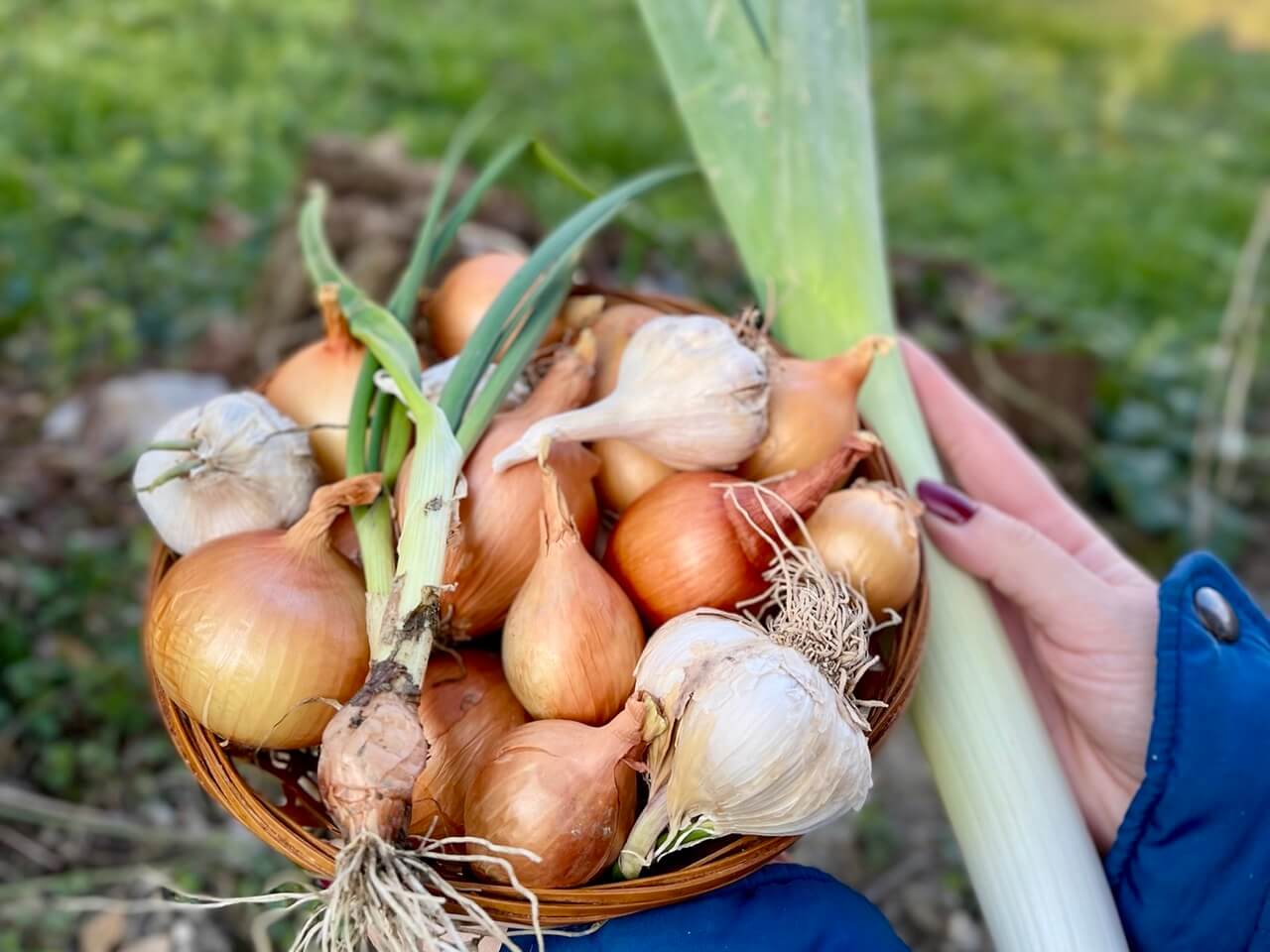Ever break out in itchy hives after chopping onions? You might have skin contact onion allergy! In this part of my “Surviving Onion Allergy” guide, we delve into this specific reaction, exploring the symptoms, diagnosis, and practical lifestyle adjustments to help you navigate an onion-free life.
This article is the second part of my Surviving Onion Allergy guide. Getting diagnosed with allium allergy (onion is one of the plants of the allium family) made me change my lifestyle a lot. And with changing the lifestyle, there is a lot of research involved. I gathered this knowledge and created this extensive guide about onion allergy.
Check Out My Surviving Onion Allergy Guide:
What is a skin contact onion allergy?
A skin contact onion allergy is an allergic reaction that occurs when the skin comes into direct contact with onions or products containing onions. This type of allergy is usually classified as contact dermatitis, which means the skin reacts when exposed to the allergen.
Symptoms of skin contact onion allergy
The symptoms of a skin contact onion allergy can vary from mild to severe and may include:
- Redness and inflammation of the skin
- Rash or hives
- Itching or burning sensation
- Swelling
- Blisters
- In severe cases, anaphylaxis
It’s essential to recognize these symptoms promptly to seek appropriate management from your healthcare provider.
Diagnosis
Diagnosing a skin contact onion allergy shares similar principles with diagnosing other allergies, but may involve some specific considerations. Medical professionals like allergists diagnose it through a multi-step process:
Important! These tests should only be conducted by qualified healthcare professionals for accurate diagnosis and proper management of your allergy.
Understanding skin contact onion allergy: key steps for management
Managing a skin contact onion allergy involves strict avoidance of onion and onion products and cautious awareness. This includes avoiding direct contact with onions and products containing onions, reading labels carefully, and paying attention to terms like “flavoring,” “spice,” and “natural flavor,” as they might indicate hidden onion presence.
The most efficient management of skin contact onion allergy would be completely avoiding the onions and onion products. If you accidentally come in contact with onions and experience an allergic reaction, here are a few action steps:
- Wash the affected area with soap and water.
- Apply a cold compress to reduce inflammation.
- Following your doctor’s prescribed treatment plan, which may include topical corticosteroids, antihistamines, or other medications.
- Remember, in severe cases (e.g., trouble breathing, swelling of the face or throat), immediate medical attention and potentially epinephrine may be necessary.
All the action steps listed here are only for informational purposes and they can’t replace advice that you got from your allergists or GP!
Living onion-free: practical lifestyle adjustments for skin contact allergy
As with every allergy, life adjustments are needed for the best allergy management. With lifestyle adjustments, you are lowering the risks of allergic reactions. There are 2 are two key areas of lifestyle adjustment for skin contact onion allergy.
Dietary modifications
In addition to avoiding direct skin contact with onions, individuals with onion allergy may need to make dietary modifications to eliminate or reduce onion consumption. Here are 3 practical tips to minimize your risk:
Personal care products
Some personal care products can contain onion extracts or derivatives. You can find them in certain shampoos, conditioners, and skincare products. Opt for onion-free alternatives to minimize the risk of allergic reactions. When trying a new personal care product, always patch-test before applying it fully. Patch-test is performed by applying a small amount to your inner arm and waiting 24-48 hours for any reactions.
How to recognize onions in personal care products?
Reading labels is the first step. However, onions can be hidden under different names.
Here are a few names that producers use to hide onions, and onion derivatives:
Whenever you are in doubt if the personal care product is safe for you, contact the producers. Whenever you are trying new personal care products, always patch-test on a small area of your skin before applying them fully.
FAQ about skin contact onion allergy
Can a skin contact onion allergy lead to a more severe reaction?
While most reactions to a skin contact onion allergy are mild, in some cases, repeated exposure or prolonged contact with onions could potentially lead to a more severe allergic response. It’s essential to seek medical attention if you experience difficulty breathing, swelling of the face or throat, or other signs of a severe allergic reaction.
Are there any cross-reactivities with other allergens?
Individuals with a skin contact onion allergy often have sensitivities to other members of the Allium family, such as garlic, leeks, and chives. Less commonly, some individuals may experience cross-reactivity with other allergens, such as pollen or specific fruits and vegetables. This can include fruits related to birch pollen (e.g., apple, pear, cherry) or those related to latex (e.g., avocado, banana).
Can a skin contact onion allergy develop suddenly?
While most people with skin contact onion allergy experience reactions upon initial exposure, it’s important to note that allergies can develop at any time due to various factors like increased sensitization over time or changes in the immune system. If you suspect an onion allergy, regardless of how long ago you first encountered it, seek medical attention to confirm the diagnosis and discuss proper management strategies.
What are the common symptoms of skin contact onion allergy?
Common symptoms include redness, itching, swelling, and in severe cases, anaphylaxis.
How is skin contact onion allergy diagnosed?
Diagnosis typically involves a medical history review, physical examination, and allergy testing.
Conclusion
While managing a skin contact onion allergy requires careful attention, and it can be very challenging, it’s highly navigable with proper precautions and treatment. By following your healthcare professional’s guidance and actively managing your condition, you can significantly reduce your risk of reactions and enjoy a fulfilling life. If you suspect you might have this allergy, don’t hesitate to consult a healthcare professional for an accurate diagnosis and personalized plan.
Disclaimer: This overview of onion allergy is only for information purposes and it does not replace advice from your healthcare provider. All the information here is only to inform you, not to diagnose you. If you have any symptoms or you suspect that you have an onion allergy, consult your GP first.





